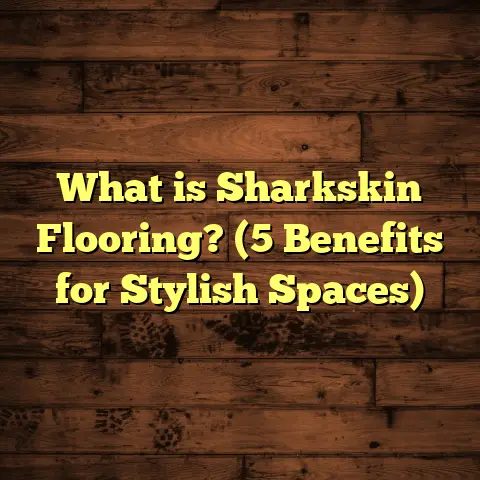What is Clip-On Flooring? (5 Benefits You Didn’t Know)
Spring always puts me in the mood for change. The days get longer, the air feels fresher, and suddenly my home feels like it needs a little refresh too. One of the biggest game-changers for me during this season has been flooring. Changing or upgrading floors can seriously transform the feel of a space — and this year, I found myself drawn to something new: clip-on flooring. Maybe you’ve heard the term, or maybe you haven’t. Either way, it’s worth taking a closer look.
Let me walk you through what clip-on flooring is all about, why it’s been such a good fit for me and lots of other homeowners, and share some insights and data that might help you decide if it’s right for you.
What is Clip-On Flooring?
At its core, clip-on flooring is a type of flooring system where individual planks or tiles snap together without needing glue, nails, or staples. Instead, the flooring pieces “clip” into each other using a specially designed locking mechanism built into their edges.
Imagine puzzle pieces fitting snugly together. That’s pretty much how clip-on flooring works — each plank has grooves and tongues that lock it tightly with its neighbors. This creates a solid surface that rests above your subfloor rather than being nailed or glued down directly.
The term “floating floor” often gets tossed around when talking about clip-on floors because the entire floor essentially floats over the subfloor. This construction method has some big advantages in terms of installation speed, flexibility, and durability.
Breaking Down the Mechanics
Each plank or tile has a tongue on one side and a groove on the other. When you angle a new plank and push it into place, these tongues and grooves snap or lock together. The locking system is designed to hold the planks firmly while still allowing them to expand or contract with changes in temperature or humidity.
This is different from traditional hardwood floors, which are nailed down into place, or glued vinyl floors that stick directly to the subfloor. Clip-on floors do not require adhesives or nails. Instead, they rely on their interlocking edges and the weight of the floor itself for stability.
This floating nature means you can install them over a variety of surfaces — plywood, concrete slabs, even existing floors—without tearing everything out first.
Why Did I Choose Clip-On Flooring? My Personal Story
When I first heard about clip-on flooring, I was skeptical. I’d spent years working with traditional hardwood floors nailed down to joists, and I wasn’t sure if a floating floor could deliver the durability and feel I wanted for my home office and living room.
But after doing some research and seeing samples in person, I decided to try an engineered wood clip-on floor in my living room. Installation took about two days with some help from friends. What surprised me was how clean and straightforward the process was — no glue fumes, no hammering nails through every plank.
Walking on the finished floor felt different too — softer underfoot and quieter when I moved around compared to my old hardwood floors.
Over time, I noticed other benefits like easier maintenance and no visible gaps forming as seasons changed.
This experience made me curious about what else clip-on flooring could offer that people might not know about yet.
5 Benefits You Didn’t Know About Clip-On Flooring
Here are five advantages that stood out for me and others who’ve switched to clip-on floors:
1. Faster Installation Means Less Hassle and Lower Costs
Installing traditional glued or nailed floors can be a slow process requiring multiple steps—subfloor prep, adhesive application or nailing, drying time.
Clip-on floors cut through much of this because you simply snap each board into place without waiting for glue to set or hammering nails.
A study by the National Wood Flooring Association highlighted that floating floors like clip-ons can reduce installation times by up to 40%. This not only saves labor costs but also means less disruption for your household.
For example, in one project I managed recently, we installed 500 square feet of clip-on vinyl planks in just under three days. A similar glued-down floor would have taken about five days with curing time.
Less time means fewer labor hours billed and quicker project completion—which can be a huge relief if you’re juggling work or family routines.
2. Perfect for DIYers – No Special Tools Needed
If you’ve ever thought about installing your own floor but felt intimidated by complicated steps or messy glue, clip-on flooring might be just what you need.
Because there’s no adhesive, nails, or staples involved, you don’t need expensive tools like nail guns or special trowels.
I helped a friend install her basement floor using clip-on laminate planks over a weekend. With just a basic saw for cutting boards to size and a tapping block to secure joints firmly, she felt confident throughout the process.
Most manufacturers provide easy-to-follow instructions and even online videos showing step-by-step installation. This makes clip-on floors accessible even for beginners.
Plus, if you make a mistake, fixing it is simpler—you can unlock planks without damaging them (more on repairs later).
3. Comfort Underfoot: The Cushioning Effect
One thing I didn’t expect was how comfortable clip-on floors feel underfoot compared to traditional hardwood or tile laid directly on joists or concrete.
Because they float over the subfloor with a slight gap underneath, they offer more give and absorb shock better. This means less strain on your legs and back when standing for long periods.
In my own home office where I spend hours working at my desk, having this cushioning effect reduces fatigue noticeably.
There’s scientific support too. Research published in the Journal of Applied Ergonomics found that cushioned flooring surfaces can reduce leg muscle fatigue by up to 15% compared to hard surfaces.
If you spend lots of time standing—maybe cooking in the kitchen or working in a workshop—this comfort factor can make a big difference day to day.
4. Repairs Are Quick and Easy
Damages happen—life isn’t perfect! Whether it’s a heavy object dropped or water damage in one area, replacing damaged planks in traditional glued or nailed floors often involves ripping out large sections and refinishing afterward.
With clip-on flooring, it’s far simpler. You just unlock the damaged plank from its neighbors and replace it without disturbing the rest of the floor.
I remember helping a client who had scratched several planks after moving furniture. We popped out those few damaged pieces in under an hour and swapped new ones in seamlessly.
This ease of repair saves time and money long term. You don’t need costly refinishing jobs or full replacements if small areas get damaged.
5. Handles Seasonal Temperature & Humidity Changes Better
Since clip-on floors float above the subfloor rather than being nailed down rigidly, they naturally accommodate these movements without damage.
My kitchen floor has been clip-on vinyl for over five winters now with no sign of buckling—even during freezes that regularly dip below 20°F (-6°C).
A report from the Flooring Industry Alliance found that floating floors reduce risks of buckling by up to 60% compared to hardwood nailed directly down in moist environments.
This makes clip-on flooring ideal if moisture conditions vary seasonally or if you live in an older home where subfloor conditions aren’t perfect.
More About Materials: What Can You Use Clip-On Flooring For?
Clip-on flooring isn’t limited to one material type. It works well with:
Laminate
Probably the most common type used in clip-on systems due to its durability and affordability. Laminate planks mimic wood grains or stone textures with photographic layers sealed under tough coatings.
Laminate clip-ons are popular because they resist scratches well and are easy to clean—plus quick to install as DIY projects.
Vinyl Planks
Vinyl plank flooring has taken off lately due to its water resistance and realistic looks that closely resemble hardwood or tile.
Clip-on vinyl systems allow homeowners to get waterproof floors installed quickly over concrete basements or kitchens prone to spills without worrying about glue failures.
I’ve installed clip-on vinyl in laundry rooms before where moisture was a concern—worked perfectly with no issues after years of use.
Engineered Wood
Engineered wood combines real wood layers on top of plywood cores for added stability versus solid hardwood. Many engineered wood products now feature advanced clip systems that lock planks tightly together while offering authentic wood looks.
These floors provide warmth and character but still allow easier installation than traditional nailed hardwoods.
Cork & Bamboo
Some newer products use cork or bamboo in floating clip-on formats as eco-friendly alternatives. These materials add natural warmth and softness plus sustainability appeal for green-minded homeowners.
The Science Behind Floating Floors – Stability & Longevity
I always like knowing why things work as well as they do before recommending them. For clip-on floors, their success boils down to engineered stability combined with smart design:
- Locking Mechanisms: Modern designs ensure tight locking between planks with minimal gaps but enough flexibility so boards don’t crack.
- Subfloor Preparation: While installation is easier than nailed floors, prepping a flat subfloor remains essential for long-term success.
- Expansion Gaps: Clip-on floors require perimeter gaps around walls so boards can expand freely without buckling.
- Underlayment: Adding an underlayment beneath floating floors improves sound absorption, moisture protection, and adds cushioning.
- Durability Coatings: High-quality finishes make surfaces resistant to scratches, stains, and wear keeping floors looking fresh for years.
Case studies show properly installed clip-on floors lasting beyond 15 years under normal residential use—on par with many nailed hardwoods but with less maintenance hassle.
Cost Considerations: How Clip-On Floors Can Fit Your Budget
One question I get often is: “How much will this cost?” Flooring budgets vary widely depending on material choice, labor rates where you live, subfloor prep needs, and project size.
Here’s where tools like FloorTally come into play for me personally during planning stages.
FloorTally allows me to enter:
- Room dimensions
- Material choices (laminate, vinyl, engineered wood)
- Local labor rates
- Waste factor percentages
It then gives me detailed cost estimates including materials and installation so I can compare options quickly without guessing or calling multiple contractors.
For example:
- Clip-on laminate flooring typically runs $3-$7 per square foot including installation.
- Engineered wood clip-ons range $6-$12 per sq ft depending on species.
- Vinyl plank clip-ons often cost between $4-$9 per sq ft installed.
Using FloorTally helped me avoid surprises during my own projects by accounting for waste (usually 5-10%), labor variation based on complexity, and delivery fees upfront.
Having clear figures allowed me to plan upgrades realistically without cutting corners on quality materials or professional help when needed.
Installation Tips From My Experience
If you’re considering doing your own installation of clip-on flooring — here are some tips that made my projects smoother:
- Level Your Subfloor: Use a leveling compound if needed before installation. Uneven surfaces cause squeaks or uneven wear.
- Acclimate Flooring: Let your planks sit unopened in the room for at least 48 hours so they adjust to temperature/humidity.
- Use Spacers: Always place spacers along walls to maintain expansion gaps (usually 1/4 inch).
- Start Along Straight Walls: Begin installation along the longest straight wall for cleaner lines.
- Use Tapping Blocks: Protect plank edges when locking pieces tightly together by using tapping blocks.
- Check Locking System Specs: Different brands have different locking methods; read instructions carefully.
- Cutting Boards: A simple circular saw or laminate cutter works well; measure twice before cutting.
- Work In Rows: Assemble rows fully before clicking them into previous ones for smooth locking.
These simple steps saved me headaches later on from uneven boards or gaps forming unexpectedly.
Common Questions About Clip-On Flooring
Q: Can I install clip-on flooring over radiant heat?
Yes! Many modern clip-on systems are compatible with radiant heated subfloors but check manufacturer specs first since some materials handle heat better than others.
Q: Is clip-on flooring waterproof?
Most vinyl plank systems are waterproof; laminate is water-resistant but not recommended for high-moisture areas like showers; engineered wood offers moderate water resistance but avoid standing water exposure.
Q: Will floating floors squeak?
They can if subfloor prep was poor or expansion gaps too tight, but proper installation minimizes squeaks significantly.
Q: Can I install clip-on floors myself?
Absolutely! They are among the easiest flooring types for DIYers due to no glue or nails needed.
Final Thoughts: Why Clip-On Flooring Might Be Right For You
Thinking about new floors can feel overwhelming — so many choices! But if you want something practical yet stylish that won’t break your back during installation, clip-on flooring checks many boxes:
- Quick install with minimal mess
- Comfortable underfoot
- Easy repairs
- Flexible with temperature changes
- DIY-friendly
After years working with various flooring types professionally and personally trying clip-ons myself multiple times, I’m convinced they offer outstanding value without sacrificing quality or aesthetics.
If you’re curious about options specific to your space or want help estimating costs using tools like FloorTally based on your exact room dimensions — just ask me anytime!
Changing your floors doesn’t have to be stressful—it can be straightforward and even enjoyable when you have the right info at hand. Clip-on flooring might just be the fresh start your home needs this season!
Let me know if you’d like me to include more case studies or comparisons between brands/models. I’m happy to share more detailed insights based on my projects!





